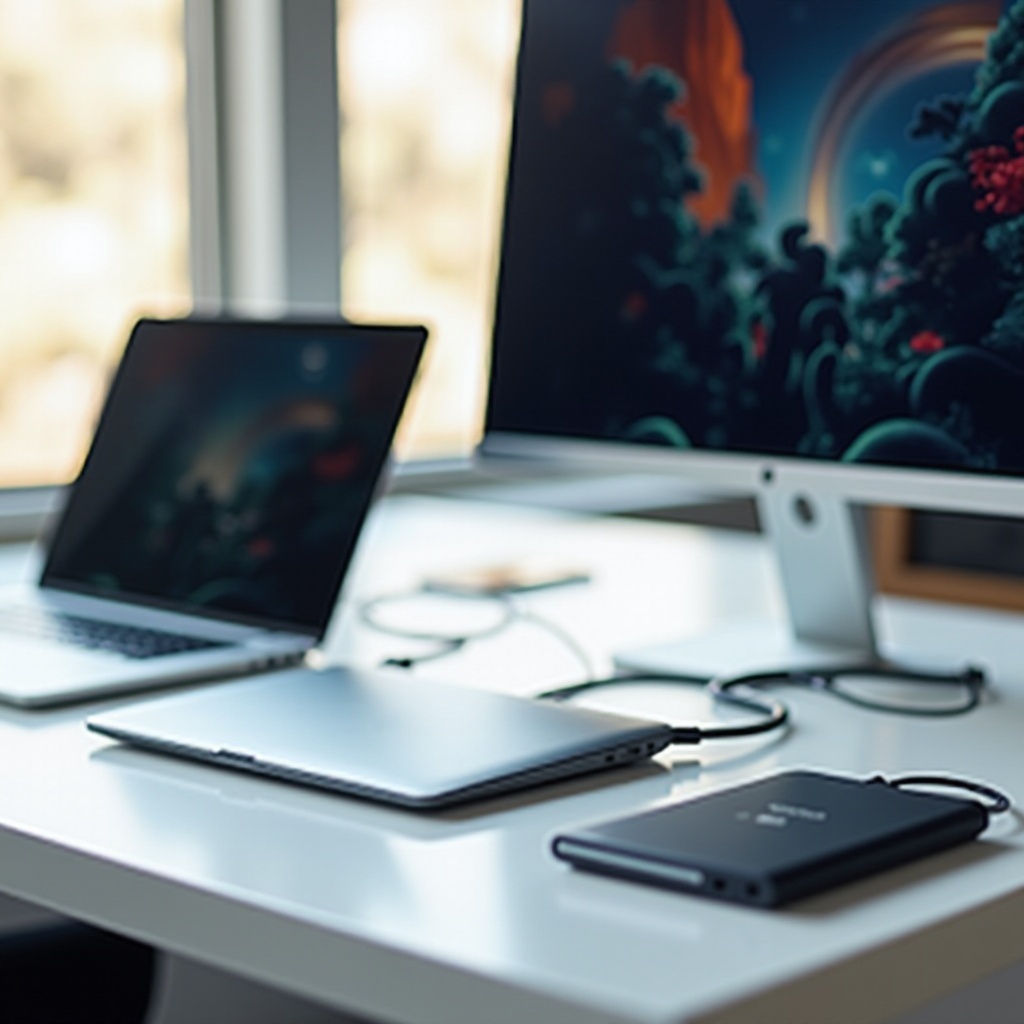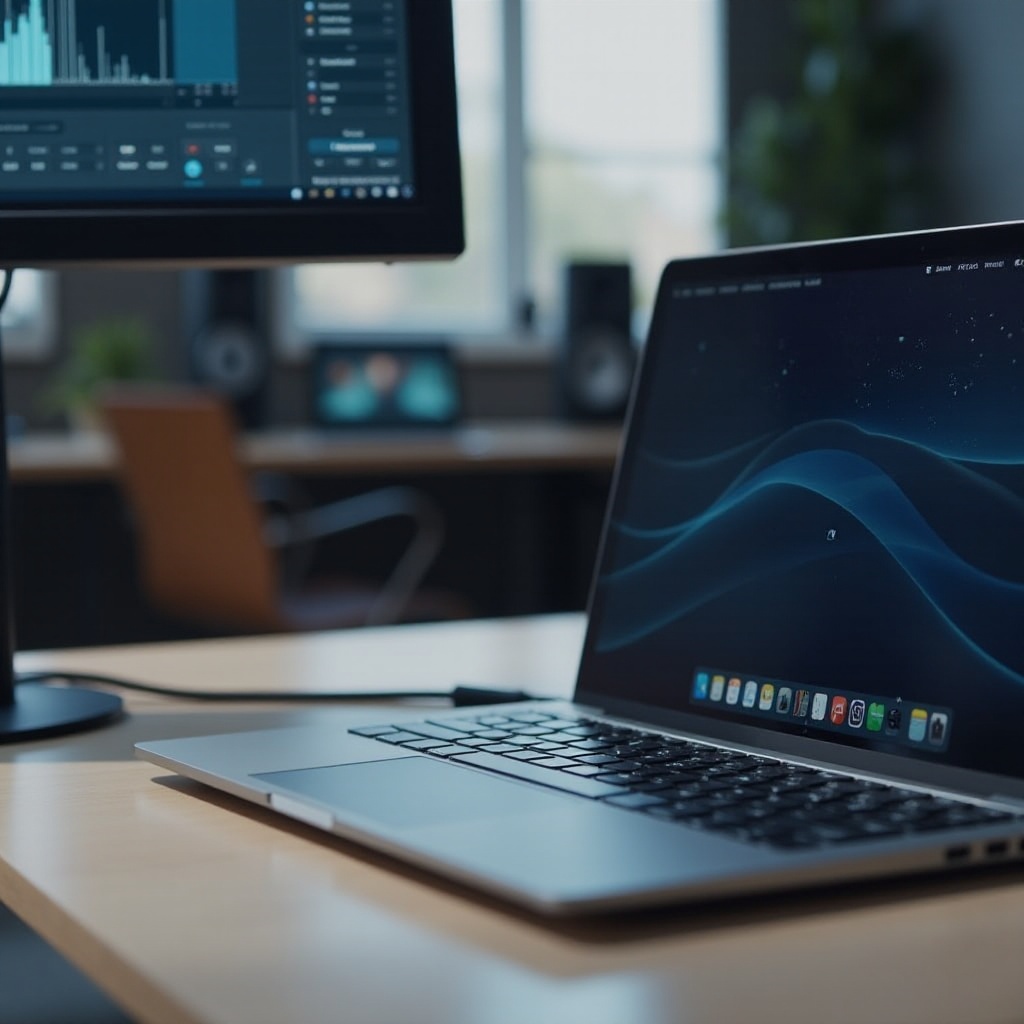Introduction
Connecting a DisplayPort monitor to an HDMI laptop can open up a wide range of display setups for work or play. Such a connection is crucial if you need to expand your visual workspace or enhance your viewing experience with a higher-quality monitor. However, the process might seem daunting if you’re unfamiliar with the different types of ports and cables. Fortunately, achieving this connection is straightforward with the right equipment and steps.

Understanding DisplayPort and HDMI Technologies
Both DisplayPort and HDMI are widely used interfaces for transmitting audio and video from a source to a display.
DisplayPort: Developed by the Video Electronics Standards Association (VESA), DisplayPort is renowned for supporting high resolution, high refresh rates, and robust multitasking capabilities. It also features unique locking connectors to ensure stable connections and can drive multiple displays from one output.
HDMI (High-Definition Multimedia Interface): HDMI is ubiquitous in consumer electronics. Its main draw is the ability to deliver video and audio through the same cable, making it highly convenient for home entertainment systems. HDMI supports features like Ethernet data connection, lossless digital audio, and CEC (Consumer Electronics Control) for device interoperability.
Understanding these two technologies provides clarity on why you might need an adapter to connect a DisplayPort monitor to an HDMI laptop.
Requirements and Pre-requisites
Before diving into the connection process, ensure you have the necessary components:
- DisplayPort to HDMI Adapter/Cable: You can’t just use any cable; it must be specifically designed to convert DisplayPort signals to HDMI.
- DisplayPort Monitor: Make sure your monitor has a functional DisplayPort input.
- HDMI-enabled Laptop: The HDMI port should support the resolution and refresh rate you intend to use.
- Appropriate Cables: Quality HDMI cables are crucial for maintaining signal integrity during the connection.
With these essentials ready, you can proceed with the connection steps.
Step-by-Step Connection Guide
Once you have your equipment in order, you can follow one of the methods to connect your DisplayPort monitor to your HDMI laptop. Here’s how to use an adapter or a direct cable.
Using a DisplayPort to HDMI Adapter
- Connect the Adapter:
- Plug the DisplayPort end of the adapter into your monitor.
- Attach the HDMI Cable:
- Connect one end of the HDMI cable to the adapter’s HDMI port.
- Plug the other end into the HDMI port on your laptop.
- Power Up:
- Turn on both your laptop and monitor to establish the connection.
Using a DisplayPort to HDMI Cable
- Direct Connection:
- Use the DisplayPort end of the cable and insert it into the monitor’s DisplayPort input.
- Connect HDMI:
- Plug the HDMI end of the cable into your laptop’s HDMI port.
- Power On:
- Like the adapter method, turn on both devices to secure the connection.
Once connected, your laptop should automatically detect the external display. Next, you’ll need to configure your laptop’s settings.
Configuring Display Settings on Your Laptop
After physically connecting your devices, next set up your laptop to ensure it optimally uses the external monitor.
Windows Settings
- Open Display Settings:
- Right-click on your desktop.
- Select ‘Display settings’.
- Detect Displays:
- Click on ‘Detect’ to find the new monitor.
- Adjust Resolution:
- Select the external monitor and adjust the resolution based on your monitor’s specs.
- Select Display Mode:
- Choose your preferred display mode (Duplicate, Extend, Second screen only) from the ‘Multiple displays’ dropdown.
Mac Settings
- Open System Preferences:
- Go to the Apple menu and select ‘System Preferences’.
- Displays Option:
- Click on ‘Displays’.
- Arrangement Tab:
- For configurations like mirroring or extending the desktop, switch to the ‘Arrangement’ tab.
- Resolution Adjustment:
- From the ‘Display’ tab, scale the resolution to match your monitor for optimal display quality.
Troubleshooting Common Issues
Occasionally, issues may arise. Here’s how to handle some common problems:
No Display Signal
- Check Connections:
- Ensure cables are securely connected.
- Power Cycle:
- Turn off both the laptop and monitor, unplug, then reconnect.
- Display Mode:
- Confirm that the correct display mode (Extend or Duplicate) is selected.
Resolution Issues
- Adjust Settings:
- Go back to Display settings on your laptop and ensure the resolution matches your monitor’s native resolution.
- Update Drivers:
- Check for and install any driver updates for your graphics card.
Audio Problems
- Set Audio Output:
- In the Windows sound settings or Mac’s sound preferences, ensure the external monitor is selected as the default audio device.
- Check Monitor Speakers:
- Ensure the monitor’s internal speakers are enabled and functioning.

Optimizing Display Quality
For the best visual experience, you might need to make some tweaks:
Adjusting Resolution and Refresh Rates
- Ensure the resolution matches the native resolution of the monitor.
- Higher refresh rates result in smoother visuals, adjust them in display settings where applicable.
Color Calibration Tips
- Most operating systems have built-in tools for color calibration. Run these to ensure colors are accurate.
- Use third-party software for more precise adjustments based on professional needs.

Conclusion
Connecting a DisplayPort monitor to an HDMI laptop is a manageable task if you follow the right steps and have the proper equipment. Whether you’re using an adapter or a dedicated cable, and configuring appropriate display settings, you’re set for an expanded, improved display setup.
Frequently Asked Questions
Can I connect multiple monitors using a single adapter?
It depends on the adapter. Some advanced adapters can support multiple monitors, but most standard adapters generally support only one monitor.
Do all adapters support 4K resolution?
Not all adapters are built equally. Ensure the adapter you purchase is rated for 4K resolutions if you need it.
What if my adapter isn’t working properly?
Check and reseat all connections, ensure all drivers are updated, and try the adapter on a different monitor or laptop to isolate the issue.